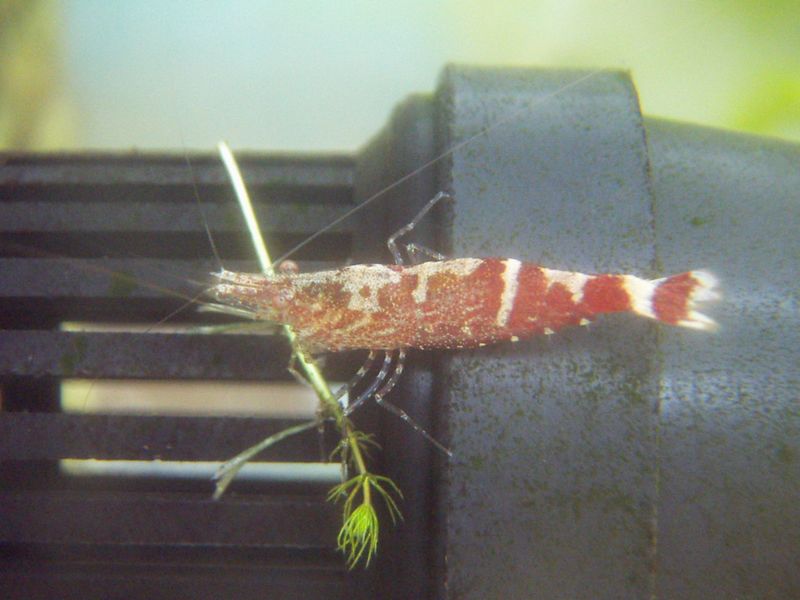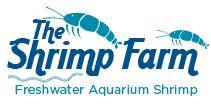Shrimp caresheet: Ninja shrimp (Caridina serratirostris)
As if shrimp weren't cool enough already, this one can do a magic trick: it changes color! Caridina serratirostris, also known as the ninja shrimp, can vary in color from orange to black depending on the environment. Not the most common shrimp out there, but definitely worth a try if you can find some.
Keep reading for everything you need to know about ninja shrimp and keeping this fascinating Caridina variety in your own aquarium.
| Scientific name | Caridina serratirostris |
| Common name | Ninja shrimp |
| Difficulty level | Easy |
| Origin | Indo-West Pacific |
Table of Contents
Caridina serratirostris requirements
Because ninja shrimp are dwarf shrimp that stay very small, they don't need a large aquarium to thrive. A setup of at least 5 gallons should be enough to keep them happy and healthy, although something slightly more spacious (like a 10 gallon) is easier to keep clean and might be preferable if you're a beginner.
As with all shrimp and fish, a ninja shrimp aquarium should always be filtered. You don't need a large or very powerful filter, just something to house the beneficial bacteria that keep your aquarium safe. A sponge filter should be fine; steer clear of anything that has an intake large enough to suck up shrimp. You'll also need a heater to keep the water stable and at the right temperature.
Ninja shrimp aren't picky when it comes to decor, but they do appreciate plenty of hiding and foraging spots. Live plants like Java moss are always a plus. You can also include shrimp tubes, rocks and driftwood to imitate their natural habitat.

Water quality
Water quality is the key to successful shrimp keeping, and this is no different with ninja shrimp. Never introduce any shrimp (or other livestock) if your aquarium isn't fully cycled yet. Keep the water quality high by doing regular water tests with a liquid test kit, topping off any water that has evaporated and doing water changes when needed.
An important note: unlike many other dwarf shrimp, ninja shrimp like their water pretty toasty. They naturally occur in relatively warm areas and won't do well in an unheated aquarium. Make sure you get a working heater (preferably with a thermostat) and check your thermometer regularly to make sure temps are still where they're supposed to be.
pH: 6.5-8
Temperature: 75-80.5
Tankmates
Most shrimp enthusiasts will know the drill by now: don't keep shrimp that you value greatly with any but the most peaceful and tiny fish species. Pygmy Corydoras and other microfish won't be able to fit adult shrimp into their mouths and should be fine. If you get larger fish, you'll have to accept the possibility of them eating the occasional shrimp.
If you want to keep things completely shrimp safe, go for an invert-only setup. Snails and other shrimp species that won't interbreed with your ninja shrimp (like cherry shrimp from the Neocaridina genus) should work well.

Caridina serratirostris diet
Ninja shrimp are scavengers that will consume anything edible they come across. In the wild, they live off microfilm, decaying organic matter and algae. This makes them a great aquarium cleaning crew, but keep in mind that our fish tanks might be too clean to sustain an entire population off detritus alone.
To make sure your ninja shrimp don't go hungry, regularly offer high-quality shrimp foods and other snacks they love (try fresh blanched veggies and leaf litter).
Breeding Caridina serratirostris
Information on breeding ninja shrimp is quite scarce and I was unable to find any successful breeding reports. The process is likely similar to breeding Amano shrimp: the fry go through a larval stage before turning into 'actual' shrimp. To make matters even more difficult, they also require brackish water in these first stages of life, after which they should slowly be acclimated to freshwater.
Amano shrimp breeding teaches us that any errors quickly lead to dead fry. Still, it likely can be done if you can figure out the correct salinities and when to move the fry to freshwater.
Buying Caridina serratirostris
These shrimp are not common in the hobby and some sources state they have never been imported to both Europe and the US. Luckily, this is not true: you should actually be able to find them if you do a bit of searching.
Try asking if your local aquarium store can order some from their wholesaler, or approach different wholesalers yourself to see if they can help you out.



 Shrimp
Shrimp Fish
Fish Crab &
Crab & Plants
Plants Foods
Foods Snails
Snails
1 Comment